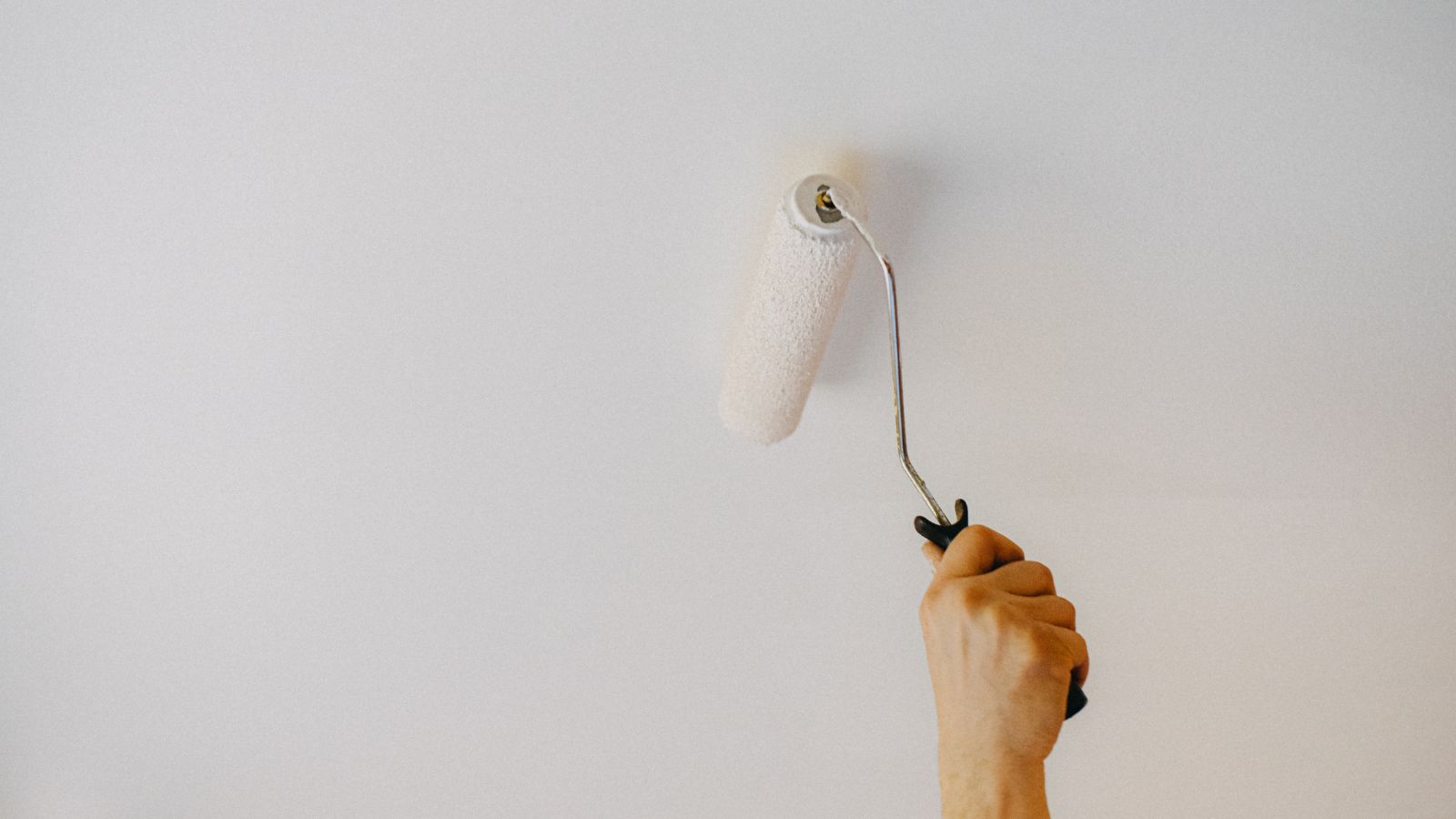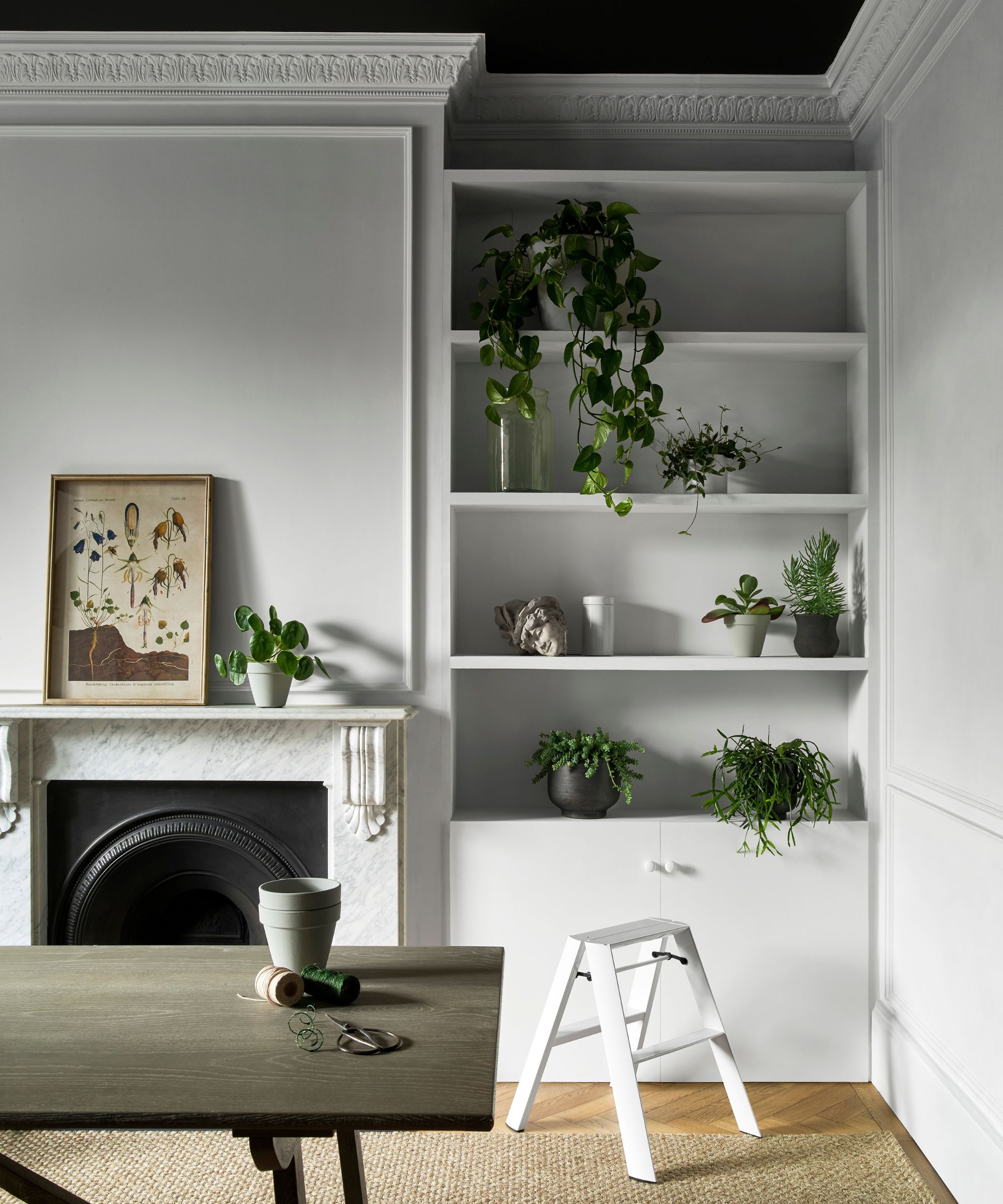Decorating professionals reveal the common ceiling painting mistakes to avoid
'Even if you don't think you will notice them from the ground, you will'


Boldly decorated ceilings continue to dominate trends in 2023, but painting the fifth wall is not an easy task – especially for a home DIYer. There are many ceiling painting mistakes you'll need to avoid if you want to execute it effectively at home.
When painting a ceiling it can be tempting to think of it as ‘just another wall,’ but working at height and on an angle makes it one of the most awkward surfaces to paint in a home.
Here, professional painters and decorators share the eight ceiling painting mistakes to avoid if you want your ceiling’s new dramatic impact to be because of the new color, not because of a truly dreadful paint job.
Ceiling painting mistakes to avoid

Making these ceiling painting mistakes may not be fatal, but they are certainly a nuisance. Here is how to avoid them.
1. Leaving it 'til last
Many people question whether you should paint trim or walls first, but forget about the ceiling. This space should never be left till last, says Zak Fleming, professional handyman and founder of Express-Handyman. Otherwise, it could end up causing damage to other fresh paint jobs.
'The ceiling should really be painted first to prevent drips and spray splashing down onto walls and trim,’ he explains. ‘This allows for a cleaner and more efficient process when painting the rest of the room.’

Zak Fleming CGR, is a Master Electrician, 2016 Remodeler of the Year and member of Professional Remodeler’s 40 under 40 class of 2014. He has over 20 years of experience in all facets of the construction industry.
2. Neglecting to prep the space
Preparing a ceiling for painting is much like preparing walls for painting, and should not be skipped if you want the job to be done properly the first time.
Dust will prevent paint from adhering properly, for example, so cleaning is essential, professional handyman Zak Flemming continues. ‘Using a primer can also improve paint adhesion and conceal any stains or discoloration,’ he adds. It also makes for a smoother finish.
3. Skimping on paint
Picking out high-quality paint finishes for your ceiling paint ideas is essential if you want the finished job to look professional and stand the test of time. After all, not all ceiling paints are created equal, Lisa McIntee, home stager at The Staging Professionals reminds us.
‘It may be tempting to buy a pail of inexpensive ceiling paint to get multiple rooms complete,’ she begins, ‘but areas like kitchens and bathrooms do require some extra love. A peeling or cracking ceiling means that moisture has gotten in behind the paint, common in kitchens and bathrooms. To avoid this, purchase the proper ceiling paint for your space, apply the paint when the room is properly ventilated and dry, and allow for sufficient drying times between coats.’
Once you have picked out the perfect paint, make sure you have enough to cover the space. High-quality paint is often not budget-friendly, but avoid skimping on how much you use for the sake of making it last.
When you squeeze every drop out of the roller before reapplying paint, you will leave an uneven coverage, warns Bart Caldwell, professional painter and founder of Caldwell Painting. ‘It will give you that DIYer look,’ he claims. ‘Keep that roller wet and keep it professional.’

Bart Caldwell is the owner of Caldwell Painting. Based in Memphis Tennessee, Caldwell Painting is on an exciting mission to use the power of paint to transform interior and exterior commercial and residential spaces.
4. Picking the wrong finish
There are so many ceiling paint finishes to pick from it can be hard to know which is best. Lisa McIntee, home stager, suggests that while you may want to create a statement with your ceiling, using a glossy finish is not always the way to go:
‘Ceilings can be highly reflecting surfaces for both natural and artificial light, choosing a paint with a glossy finish can draw the eyes up, detracting from the rest of the space and drawing attention to any imperfections.
‘Always stick with a commercially marketed ceiling paint as they typically have a low reflective matte finish. There is nothing worse than walking into a room with a glossy ceiling!’
High gloss ceilings are one of the top interior design trends this year, and we love them, but if you are going to swap matte paints for gloss paints, ensure the plastered surface is perfect – high gloss finishes highlight every lump and bump.
5. Skipping out on drop sheets
If you want to avoid the headache of getting paint out of carpet or scrubbing your furniture and wooden floors, then drop cloths are an absolute must – as is using the right material.
Protecting floors and furniture from paint splatters with plastic sheeting is better than fabric, says Zak Flemming. These don’t absorb any paint or transfer it to the surfaces below. A good option if you have carpets is these heavy-duty sticky carpet protector sheets, which you can find at Amazon, that will also protect your flooring from workman's boots and dirt.
6. Forgetting to remove light fittings
You don’t need to be an engineering major to remove a light fixture from your ceiling, and removing these obstacles will result in a professional finish and protect your hanging fixtures from unsightly paint splatters, says Zak Fleming, professional handyman. Even if you don't think you will notice them from the ground, you will.
When removing a light fitting, always make sure to turn the electricity supply off at the breaker first, not just at the switch, to prevent injury.
7. Painting in the wrong direction
Unless you are looking to texture a ceiling, rolling in different directions, or rolling against the flow of natural light can leave permanent marks.
‘Believe it or not, you need to roll your ceiling with the direction of your natural light source,’ advises Bart Caldwell, professional painter. ‘This is a little-known professional trick to help hide those pesky roller marks.’
8. Not taking breaks
Any painting job, from painting a wall to painting an entire room, calls for regular breaks. But this is even more important when it comes to painting something as awkward as a ceiling, warns Erin Nutter, DIY mentor at The DIY Nuts, a home improvement blog.
No matter if your ceiling is large or small, it can be difficult to work at heights and angles for long periods of time, she says. ‘Give your neck and shoulders a break occasionally to avoid having a stiff neck the next day.’
Ceiling Paint Roller | $39.99 at Amazon
This long-handled ceiling paint roller is ideal for working from the ground and reducing the strain on your neck and arms when painting a ceiling. Helping you to avoid more mistakes.

Erin Nutter is a self-proclaimed DIY nut who has spent most of her life helping her family fix up their homes. As a result, she has built up years of expertise in home renovating and decorating.
FAQs
Why does my ceiling look bad after painting?
There are a few reasons why your ceiling may be left looking patchy after painting. You may have used the wrong paint, applied too few coats, applied a second coat too soon, or used the incorrect equipment.
It may be because you rushed the job. Like painting a wall, painting ceilings require a lot, if not more, patience to complete properly.
Why do I have lines on my ceiling after painting?
If lines have dried into your ceiling after painting, it may be that you applied the paint unevenly or lapped wet paint over completely dry paint. This can happen if you are speeding through a painting task or apply a second coat too soon. If there are a few lines the job may be fixable with another, even coat. If there are multiple very noticeable lines, however, the painting may need to be done again.
These ceiling painting mistakes are easily avoided with time and patience. Repainting a ceiling should never be done on a whim, and spending time prepping the space first will always lead to a perfect paint job the first time around.
Sign up to the Homes & Gardens newsletter
Design expertise in your inbox – from inspiring decorating ideas and beautiful celebrity homes to practical gardening advice and shopping round-ups.

Chiana has been at Homes & Gardens for two years and is our resident 'queen' of non-toxic living. She spends most of her time producing content for the Solved section of the website, helping readers get the most out of their homes through clever decluttering, cleaning, and tidying tips. She was named one of Fixr's top home improvement journalists in 2024.
-
 5 surprising but brilliant ways to clean with old socks – from perfectly buffing stainless steel to deterring pests naturally and more
5 surprising but brilliant ways to clean with old socks – from perfectly buffing stainless steel to deterring pests naturally and moreTackle dust in tricky corners, clean your mirrors and even banish bad odors with those rogue single socks
By Andy van Terheyden Published
-
 How to grow astilbe – expert advice on cultivating this shade-tolerant flowering perennial
How to grow astilbe – expert advice on cultivating this shade-tolerant flowering perennialShade-tolerant and pest-resistant - astilbe are hardy and tough perennials that can thrive in many settings
By Ellen Wells Published
-
 7 dorm room organizing rules for less clutter and more space
7 dorm room organizing rules for less clutter and more spaceExperts offer their top tips for creating a well-organized dorm room, no matter the size, space, or layout.
By Ashley Chalmers Published
-
 How to maximize storage in a small or shared dorm room, according to pro organizers
How to maximize storage in a small or shared dorm room, according to pro organizersFind out all the hidden storage zones you might never have noticed
By Ashley Chalmers Published
